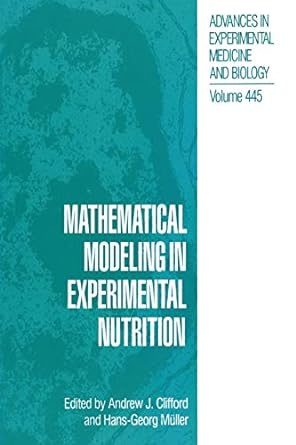Go back


Mathematical Modeling In Experimental Nutrition Volume 445(1st Edition)
Authors:
Andrew J. Clifford ,Hans-Georg Muller

Cover Type:Hardcover
Condition:Used
In Stock
Shipment time
Expected shipping within 2 DaysPopular items with books
Access to 30 Million+ solutions
Free ✝
Ask 50 Questions from expert
AI-Powered Answers
✝ 7 days-trial
Total Price:
$0
List Price: $139.58
Savings: $139.58(100%)
Solution Manual Includes
Access to 30 Million+ solutions
Ask 50 Questions from expert
AI-Powered Answers
24/7 Tutor Help
Detailed solutions for Mathematical Modeling In Experimental Nutrition Volume 445
Price:
$9.99
/month
Book details
ISBN: 1489919619, 978-1489919618
Book publisher: Springer
Get your hands on the best-selling book Mathematical Modeling In Experimental Nutrition Volume 445 1st Edition for free. Feed your curiosity and let your imagination soar with the best stories coming out to you without hefty price tags. Browse SolutionInn to discover a treasure trove of fiction and non-fiction books where every page leads the reader to an undiscovered world. Start your literary adventure right away and also enjoy free shipping of these complimentary books to your door.
Book Summary: Nutrients have been recognized as essential for maximum growth, successful reproduction, and infection prevention since the 1940s; since that time, the lion's share of nutrient research has focused on defining their role in these processes. Around 1990, however, a major shift began in the way that researchers viewed some nutrients particularly the vitamins. This shift was motivated by the discovery that modest declines in vitamin nutritional status are associated with an increased risk of ill-health and disease (such as neural tube defects, heart disease, and cancer), especially in those populations or individuals who are genetically predisposed. In an effort to expand upon this new understanding of nutrient action, nutritionists are increasingly turning their focus to the mathematical modeling of nutrient kinetic data. The availability of suitably-tagged (isotope) nutrients (such as B-carotene, vitamin A, folate, among others), sensitive analytical methods to trace them in humans (mass spectrometry and accelerator mass spectrometry), and powerful software (capable of solving and manipulating differential equations efficiently and accurately), has allowed researchers to construct mathematical models aimed at characterizing the dynamic and kinetic behavior of key nutrients in vivo in humans at an unparalleled level of detail.
Customers also bought these books
Frequently Bought Together
Top Reviews for Books
Didier Lo
( 5 )
"Delivery was considerably fast, and the book I received was in a good condition."










